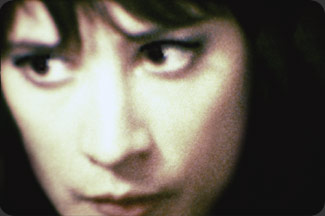 |
'Super-duper-8' is the right format for Sleep Always
Kodak's In Camera, April 2003, page 12
Sleep Always is a unique first feature by writers-directors Mitch Perkins and Rick Palidwor of Toronto. The film looks at the downtrodden, delusional character Frank and details his doomed, obsessive relationship with a beautiful homeless woman named Nada. The entire story unfolds inside of Frank's mind as a dreamy stream of consciousness.
Perkins and Palidwor knew that their film would require an unusual visual style. Toward that end, they perfected their own film format, which they dubbed "super-duper-8". Perkins came up with the idea and adapted Super 8mm cameras years before. "We're exposing the sound stripe area of the film, as with Super 16mm," he says. "During telecine we have to shrink this wide frame to fit the 4:3 television frame - we get about 30 percent more image area resulting in tighter grain, but retaining the small gauge feel."
Sleep Always was shot on Eastman Ektachrome 7240 reversal film that was processed at Exclusive Film & Video in Toronto. The lab is in the building where Perkins rents a studio. Most of the film was produced in the same building. Perkins did the film transfer himself using a modified projector. "The projector gate had to be widened to see the full super-duper-8 frame out to the edges," says Perkins. "I opened up the gate considerably, which allowed maximum flexibility and control over framing. We transferred a 4:3 image but it's matted to 1.85 letterbox - otherwise you'd see the top and bottom of the adjacent frames."
The duo never considered using digital video for Sleep Always. "Tape just doesn't measure up to film capture," says Perkins. "Texture and latitude are obvious differences, but an often overlooked consideration is the greater versatility of the film camera itself."
"The story has very little to do with reality," says Palidwor. "In that sense, it could never be told properly with videotape, which is often associated with reality. Film has that ability to convey emotion and mood, dream and fantasy."
The A-camera was a modified Nikon R10 with a 7-70mm lens. It is capable of shooting 54 frames per second, and enables in-camera fades and dissolves. "These effects are easily done in digital post but that doesn't look nearly as good, especially the slow motion," says Palidwor. "Over-cranking the camera is the best way to produce smooth slow motion. Slowing the shot down in an edit suite means repeating frames. It's a different feeling altogether. We typically prefer this 'true' slow motion, especially when you don't want to draw attention to it as an effect."
Several other cameras were also modified. Perkins devised a hand-run time-exposure camera from a broken camera. This result was a camera with an extremely variable frame rate and an erratic pulsing image that the filmmakers used to depict moments when Frank is "losing it". A Nizo S560 camera was also used. It enabled them to record from one frame per minute to 54 frames per second with the option of locking the shutter open.
Perkins and Palidwor used this capability to produce interesting motion effects to portray Frank's delusional moments. "A recurring theme in Sleep Always is Frank's continual search for Nada, so we wanted a sequence where the camera whips through the halls of the building where Frank lives, searching every nook and cranny", says Palidwor. "We walked through the halls very slowly, running the film by hand at approximately one frame per second. The result is a high-speed tour of the building with a pulsing, panicky feel to it, which perfectly mirrors Frank's state of mind. We didn't need to light the halls beyond the fluorescent overheads and the images are still hot."
"Another example is when Nada enters Frank's apartment for the first time. This is a big moment for him, one of his strongest memories, so we switched from regular motion to slow motion in mid-shot, just at the moment when Nada entered. This slow motion option allowed us to turn a mundane moment - someone entering a room - into a magical moment that Frank wishes could last forever." The format's affordability meant they could shoot with multiple cameras, which took pressure off the actors.
Perkins and Palidwor say they got creative satisfaction from breaking the rules mechanically and using the results to serve the story visually. "We like to experiment and have fun, especially with low-tech because it's more about ingenuity than money," says Perkins. "It keeps it interesting and the results can be spectacular. We've created shots where viewers assume we have a heavy-duty lighting effect going on but it's just the variable exposure. It's almost like the subject has an inner light which wants to bust out."
Copyright ©2002 Friendly Fire Films, All Rights Reserved.

